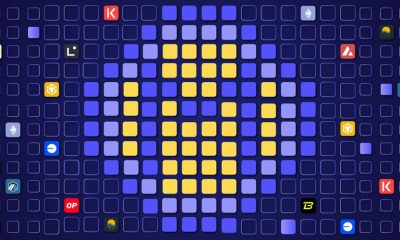Opinion
7 Best Polkadot Ecosystem Tokens to Watch
Securities.io maintains rigorous editorial standards and may receive compensation from reviewed links. We are not a registered investment adviser and this is not investment advice. Please view our affiliate disclosure.

Polkadot is a project with very high potential, and for several reasons. First of all, it functions as a development platform capable of producing smart contracts, and through them, pretty much any blockchain product ever invented. Next, it is extremely scalable thanks to its unique approach to increasing scalability.
The project, as many likely knows, employs parallel chains called parachains, which run alongside its main chain and can take over a portion of the transactions that take place on Polkadot. In doing so, they reduce the load on the main chain and make the entire network run very quickly, with no lengthy waiting times, and very low gas fees.
Finally, Polkadot’s parachains can also be used for connecting to other blockchains, thus allowing it to create a cross-chain network that could eventually grow to become the foundation for Web 3.0. With all that said, it is clear that Polkadot has great potential, and the same is true for many projects on its network, such as:
1. Celer Network
The first on the list is Celer Network — a layer-2 scaling platform application that wishes to explore new opportunities, and not only on Polkadot, but also other chains, such as Ethereum. However, Celer’s main goal is to provide off-chain transaction handling for the chain(s) it runs on.
The project has seen the issues that Ethereum’s network deals with, and while Polkadot has found a solution in offloading the work its network is seeing to parachains, Celer still believes that blockchain technology needs a secondary solution, as it will be a long time before it reaches transaction speeds fast enough to handle the working blockchain will see in the near future, as adoption shoots further up. In other words, Celer believes that there is still no solution that is fast enough to handle the transactions of the entire world.
Celer’s own solution is to offer fast, simple, and secure transactions for smart contracts that would take place off-chain. It is also worth noting that the project was among the first ones to be developed through the use of the Substrate framework.
To learn more visit our Investing in Celer Network guide.
2. Shadows
Next, we have Shadows, which is a Polkadot-based project that serves as a go-to project for lending, borrowing, and trading derivatives within this network. Shadows is, obviously, very DeFi-focused cryptocurrency project, and it allows users to gain quick and easy access to the massive derivatives industry, estimated to be worth billions of dollars.
With access to derivatives trading, Shadows believes that its users could uncover a lot of great opportunities. Its goal is to redefine investment opportunities on-chain, and in order to achieve this, it created its own decentralized application called Shadows dApp. This is a derivatives platform that is web-based, and that allows users to issue, trade, and stake derivatives.
Both the platform itself, as well as its network, are powered by the DOWS token, which brings scalability and interoperability to the network through investments in Polkadot, but also Binance Smart Chain (BSC). Users also have the opportunity to win rewards and gain utility from owning DOWS tokens, not to mention additional opportunities when it comes to accessing the derivatives market and its potential.
To learn more visit our Investing in Shadows guide.
3. Moonriver
Next, there is Moonriver, which is a smart-contract parachain built on Kusama — Polkadot's public pre-production environment. The project holds great potential, not only within Polkadot’s network, but also Ethereum’s, as it is compatible with both. Its developers had the idea of using it as a companion network to a project called Moonbeam, where Moonriver would serve as a canary network and provide an incentive to users who opt to use it as such.
As a network meant for testing and experimenting, Moonriver could bring additional benefits to those who are looking for new projects to invest in, as they would be able to identify them even before they officially go live, and see first-hand how they operate and what they hope to achieve.
Moonriver has a native token called MOVR, which serves as its utility token. MOVR can be used for a number of purposes, such as supporting the gas metering of smart contract execution, incentivizing users, powering the project’s mechanics, paying for transaction fees on Moonriver, and more.
To learn more visit our Investing in Moonriver guide.
4. Ternoa
In the fourth spot, we have a project called Ternoa, which is a decentralized data transmission network that relies strongly on non-fungible tokens (NFTs). The project uses Polkadot’s technology to offer the services of transmitting and storing data in the safest ways possible.
Upon seeing the capabilities of NFT space, as well as the great popularity that NFTs have seen recently, its developers recognized the way they can use non-fungible tokens to achieve their own goals. The NFT sector has seen great amounts of use in areas such as gaming, entertainment, metaverse, data management, or as means of preserving memories and information, like time capsules, of sorts.
As with the underlying asset tied to each specific NFT, the data that gets tokenized is just as safe, immutable, and completely owned by the NFT holder. Furthermore, data is only accessible to the owner, which means that it cannot be stolen by third parties. Furthermore, Ternoa came up with the idea of using oracles to verify the accuracy of the provided information, before it gets delivered to the NFT holder.
To learn more visit our Investing in Ternoa guide.
5. Centrifuge
Moving on, we have Centrifuge — a project that has a rather interesting use case. The project’s goal is to bring real-world assets to the blockchain, which essentially means that it aims to connect the real world with DeFi. It is a decentralized asset financing protocol that aims to reduce the cost for small and mid-sized companies. At the same time, its goal is to offer a stable source of income for investors.
Centrifuge can be used to generate profits, but in a different way than other DeFi protocols. Instead of the profits coming in the form of rather volatile digital coins, it aims to instead transfer real monetary value from fiat money to cryptocurrencies. In a way, it is not too different from how stablecoins work.
As a result of its efforts, companies will be able to use this new form of money to access the liquidity offered by the DeFi sector, tokenize assets, and even use the tokens as collateral, if they wish to access financing.
To learn more visit our Investing in Centrifuge guide.
6. Efinity
Nearing the end of the list, we have Efinity, which is a project that was built on Polkadot in partnership with Parity Technologies and the Web3 Foundation. It is a young project that was purpose-built for the NFT sector. Its goal is to help build a future where non-fungible tokens are as widespread and as easy to use as smartphones are today.
Efinity is a project that offers plenty of benefits, such as the use of smart contracts, discrete accounts, transaction fee delegation, instant swaps, crafting, price discovery, native multisig, interoperable marketplaces, and finally, an NFT launchpad. The project’s transactions get confirmed in around 6 seconds, and it is capable of offering 1000 TPS. For comparison, Ethereum can only process around 15 TPS, making Efinity a much more scalable project.
To learn more visit our Investing in Efinity guide.
7. Acala
Finally, the last project on our list is Acala. This is an all-in-one decentralized finance network that offers a platform that features Polkadot’s security, in addition to an entire suite of interoperable financial apps. The project allows users to trade on Acala Swap, and issue self-serviced loans using the Acala Dollar stablecoin.
Users can also enjoy a number of DeFi functionalities, such as becoming liquidity providers, accessing staking derivatives, and stale Liquid DOT (LDOT). In exchange for engaging with the project’s DeFi services, they stand to earn high-interest APY on the digital assets they contribute.
The project’s network is very scalable and compatible with Ethereum, which makes it an excellent choice for engaging with decentralized finance (DeFi). Furthermore, it can also be bridged to a number of other blockchains, including Ethereum, and even Bitcoin itself, among others.
Other than that, Acala is working on creating hybrid crypto/fintech products in partnership with Current, an American fintech firm.
To learn more visit our Investing in Acala guide.
Conclusion
Polkadot holds great potential, and it could very well be one of the top dogs in the very near future. The projects we discussed above are only some of those that offer great opportunities already and have great potential to take off and reach impressive gains. Of course, no one can know the future, and you should do your own research before committing to any project. But, if you were wondering where to start, the ones listed above are certainly some of the best for you to consider.












